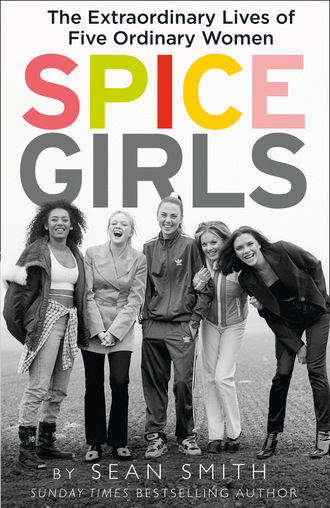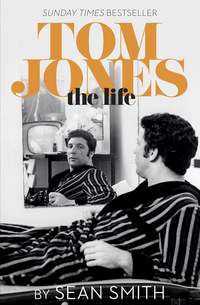
Полная версия
Spice Girls


Copyright
HarperCollinsPublishers
1 London Bridge Street
London SE1 9GF
www.harpercollins.co.uk
First published by HarperCollinsPublishers 2019
FIRST EDITION
Text © Sean Smith 2019
Cover design by Claire Ward © HarperCollinsPublishers Ltd 2020
Cover photographs © Harry Borden/Contour by Getty Images
A catalogue record of this book is available from the British Library
Sean Smith asserts the moral right to be identified as the author of this work
While every effort has been made to trace the owners of copyright material reproduced herein and secure permissions, the publishers would like to apologise for any omissions and will be pleased to incorporate missing acknowledgements in any future edition of this book.
All rights reserved under International and Pan-American Copyright Conventions. By payment of the required fees, you have been granted the nonexclusive, non-transferable right to access and read the text of this e-book on screen. No part of this text may be reproduced, transmitted, downloaded, decompiled, reverse engineered, or stored in or introduced into any information storage retrieval system, in any form or by any means, whether electronic or mechanical, now known or hereinafter invented, without the express written permission of HarperCollins e-books.
Find out about HarperCollins and the environment at
www.harpercollins.co.uk/green
Source ISBN: 9780008267582
Ebook Edition © November 2019 ISBN: 9780008267599
Version: 2020-07-02
Note to Readers
This ebook contains the following accessibility features which, if supported by your device, can be accessed via your ereader/accessibility settings:
Change of font size and line height
Change of background and font colours
Change of font
Change justification
Text to speech
Page numbers taken from the following print edition: ISBN 9780008267568
Also by Sean Smith
Ed Sheeran
George
Adele
Kim
Tom Jones: The Life
Kylie
Gary
Alesha
Tulisa
Kate
Robbie
Cheryl
Victoria
Justin: The Biography
Britney: The Biography
J.K. Rowling: A Biography
Jennifer: The Unauthorized Biography
Royal Racing
The Union Game
Sophie’s Kiss (with Garth Gibbs)
Stone Me! (with Dale Lawrence)
Dedication
To Megan
Contents
1 Cover
2 Title Page
3 Copyright
4 Note to Readers
5 Also by Sean Smith
6 Dedication
7 Contents
8 PART ONE: THE WANNABES
9 1 Irrepressible
10 2 Casting the Net
11 3 Mein Herr
12 4 In Search of the Magical Key
13 5 Melanie Chisholm Superstar
14 6 A Model Girl
15 PART TWO: HERE COME THE SPICE GIRLS
16 7 The Student House
17 8 Making It Happen
18 9 The Big Fight
19 10 Hang On to Your Knickers
20 11 The Power of Girls
21 12 The Genius of Geri
22 13 Spice All Over the World
23 14 A Schedule Not a Life
24 15 Stop Right Now
25 PART THREE: SPICE WOMEN
26 16 Nightmares and Fairytales
27 17 Dark Clouds
28 18 Baby Love
29 19 Look at Me
30 20 Reasonable Doubt
31 21 The Return of the Spice Girls
32 22 Olympic Gold
33 23 Spice World Again
34 Last Thoughts
35 Spice Stars
36 Acknowledgements
37 Select Bibliography
38 List of Searchable Terms
39 Picture Section
40 About the Publisher
LandmarksCoverFrontmatterStart of ContentBackmatter
List of Pagesiiiiviiv134567891011121314151617181920212223242526272829303132333435363738394041424344454647484950515253545556575859606162636465666768697071727374757677798081828384858687888990919293949596979899100101102103104105106107108109110111112113114115116117118119120121122123124125126127128129130131132133134135136137138139140141142143144145146147148149150151152153154155156157158159160161162163164165166167168169170171172173174175176177178179180181183184185186187188189190191192193194195196197198199200201202203204205206207208209210211212213214215216217218219220221222223224225226227228229230231232233234235236237238239240241242243244245246247248249250251252253254255256257258259260261262263264265266267268269270271272273274275276277278279280281282283284285286287289290291293294295296297298299300302303304305307308309310311312
1
Irrepressible
The five young women who would become the Spice Girls didn’t need to be outstanding singers. Nor was proven dancing ability essential. They didn’t have to possess supermodel looks or have the wit of a stand-up comedian. They needed to be ordinary girls with a sparkle that could turn them into something extraordinary. They were not easy to find.
Melanie Brown, an irrepressible eighteen-year-old from Leeds, was the first name on the Spice Girls team sheet. She had a spark and exuberance that could poke your eye out. She had no idea that she had the ideal profile to become a member of a new five-piece girl group when she left her parents’ house in Kirkstall at the crack of dawn to catch the early coach to London.
She had seen the ad for a ‘female pop group’ in the Stage newspaper – or, at least, her mother Andrea had – but she was just as interested that day in trying out for a spell as a cruise-ship dancer. That job was for the summer months so there would be sun and sea for starters, as well as a regular wage. Still, she had never come across an advertisement for a girl band before so it was worth taking a look at that as well, especially as it was in the same building off Oxford Street.
This was traditionally the time of year when stage-school wannabes would try to secure work for the summer – seaside shows or cruises were the most popular so this was something different. The advertisement didn’t mention that one of the places would ideally be filled by a young black girl.
Her colour had seldom been an advantage for Melanie, growing up in some of the tougher areas of Leeds. She was mixed race – not black – an important distinction. The locals were confused by her heritage, not sure whether she was black or white, but that didn’t stop her being the innocent target of prejudice and bullying – even being called the N-word. Fortunately, the insults didn’t curb her natural high spirits.
While such treatment was upsetting, it didn’t signal an unhappy childhood – far from it. She had a loving and supportive family, as well as a best friend, Sherrell Russell, who lived round the corner on the council estate in the Hyde Park area of Leeds where Melanie spent her first few years. The modest family home was a mile from the famous Headingley cricket ground. Sherrell was also mixed race and the two girls became inseparable, forging a lifelong bond. It helped that their mothers were also best friends.
Melanie’s parents always encouraged her to fight her own battles, fully aware of the hurdles she would face. Life had been much more difficult for them in facing the full wrath of ignorant discrimination. Her father, Martin Wingrove Brown, was from Nevis, an island in the Caribbean renowned for its beautiful beaches and its reputation as a safe tax haven. As a baby, Martin was left behind to live on a small farm with his grandmother while his parents formed part of the Windrush generation of the 1950s seeking a better life in Britain.
Martin grew up playing cricket on the beach while his parents had to cope with the rampant racism of Britain during the post-war era when a commonplace sign in the windows of guesthouses would read, ‘No Irish, No Blacks, No Dogs’. It was a huge cultural change for Martin when his parents decided the time was right for him to join them in the middle of a northern winter. He had just turned nine. His new home was in the depressed and depressing area of Chapeltown in Leeds, where the Yorkshire Ripper committed so many grisly murders in the mid- to late seventies.
Melanie describes her handsome father as a ‘cool, charismatic dude’. On a Christmas Eve night out in Chapeltown, Martin, aged nineteen, met seventeen-year-old bubbly blonde Andrea Dixon. The attraction was mutual. She lived in the district of Seacroft, an area on the east side of the city, where the black population was practically non-existent at the time and skinhead gangs were thriving – which Melanie found particularly upsetting as she grew up.
They had been going out for more than two years, as well as taking the daring step of moving in together, before Melanie Janine Brown was born on 29 May 1975 at the Maternity Hospital in Leeds. They married three months later at the city’s register office, which was the first time their families had met.
Melanie still recalls being told of bus journeys when, as a baby, she would be handed to Martin to protect him, not her, as he was less likely to attract trouble when he was holding a tiny girl. Fortunately, in time, Martin and baby Melanie were properly accepted by Andrea’s family – and she by his, although everyone understood the difficulties they would face.
For much of her childhood, Melanie shared a room with her sister Danielle, who was five years younger. They got on about as well as sisters normally do – Melanie would be mean to her sibling who would run off and tell Dad.
Nobody could fault Martin’s work ethic. For most of his adult life he worked as a welder at the Yorkshire Imperial Metals factory in Stourton, a five-mile ride on his bicycle. Melanie proudly declared, ‘He worked his backside off to raise his family, never missing a shift.’ He would often work double the hours to make sure he could afford the annual summer camping holiday in the seaside resort of Abersoch in west Wales. Many of Melanie’s extended family would make the trip, which was the highlight of her year.
Andrea had left school at fifteen and took a number of low-paid jobs to do her bit for the family’s finances. She worked at the local C&A clothing store for eighteen years, as well as cleaning in an old people’s home. Her earnings would be invaluable when they discovered that their high-spirited daughter had a passion for dancing, which proved to be a good way of channelling her boundless energy. It was the one pursuit guaranteed to tire her out.
Melanie, aged nine, enrolled at the Jean Pearce School of Dance in Horsforth, a ten-minute bus ride up the road from the new family home in Kirkstall, Leeds. Jean was the doyenne of dance in the city. She had set up the school in 1945 and over the years had choreographed many amateur productions and pantos in the north of England.
Jean had also been responsible for the dancing in the popular Yorkshire TV series Young Showtime, which helped launch the careers of Joe Longthorne, Bonnie Langford and the Emmerdale favourite Malandra Burrows.
She worked wonders with Melanie, barking at her to point her toes and helping her develop the priceless skill for a professional dancer of being able to pick up routines quickly, having been shown the steps just once. She was also anxious to broaden her young pupils’ experiences and arranged school trips to see touring productions of Miss Saigon and Cats. Another valuable contribution Jean made to Melanie’s future was in teaching her to do her best at auditions.
At dance classes Melanie made new friends, including a local girl, Charlotte Henderson, who remains her closest friend, despite all the ups and downs of later years. Another was Rebecca Callard, a petite, pretty girl, whose mother is the popular Coronation Street actress Beverley Callard, who plays Liz McDonald in the evergreen soap.
The two teenagers saw little of one another at Jean Pearce but became best pals when they started senior school and bumped into each other on the first day. They were the new girls at the Intake High School in the West Leeds district of Bramley. The focus there was less on traditional academic work and more on the arts subjects that interested them – music, drama and dance.
Rebecca, who would go on to become a successful actress, had already appeared on TV, was good fun and introduced Melanie to the delights of smoking Marlboro Lights. She also joined her for sticky-bun binges. The two girls used to spend their lunch money on cakes and pastries and eat the lot in one break. Surprisingly, Melanie never seemed to put on weight. The teenagers were very much partners in crime, even double-dating twin brothers at one time.
Neither girl was considered star material at school. They managed very small roles in a version of the musical Godspell but that was about it. The Brown household was not especially musical, and Melanie’s love of dance was not matched by an overwhelming desire to become a concert pianist or a professional singer. She didn’t have singing lessons until much later, preferring to release her pent-up energy by bashing the drums.
Like most teenagers, she watched Top of the Pops every week. Rebecca was a big fan of Bros but Melanie couldn’t bear them. Instead, she preferred two of the biggest female artists of the eighties. Both were strong figures. First was Tracy Chapman, whose multi-million-selling self-titled first album remains a pop classic. She sang ‘Fast Car’ and ‘Talkin’ Bout a Revolution’ at the seventieth-birthday tribute to Nelson Mandela at Wembley in June 1988 when Melanie was thirteen. They were arguably the highlights of the whole event, especially as she sang them twice, filling in when Stevie Wonder had an equipment problem.
Secondly, Melanie loved Neneh Cherry, who was one of the few mixed-race pop stars at the time. Neneh’s father was from Sierra Leone and her mother from Sweden. She had a distinctive style that included large medallions and rugby shirts that Melanie tried earnestly to copy.
Neneh caused a mild sensation when she performed her hit ‘Buffalo Stance’ on Top of the Pops in the autumn of that year. She was the first artist to appear on the show while heavily pregnant, which was not a look normally endorsed by the male-dominated music business. It was a bold move by a young woman who defied convention throughout her career – someone with whom Melanie Brown could readily identify. Nearly ten years later, a pregnant Melanie would follow that particular girl-power lead.
Needless to say, Neneh’s ‘stance’ caused a media storm. One male TV interviewer asked if it was safe for her to go on stage in her condition and received a sharp riposte: ‘Of course. I’m not ill.’ Neneh later elaborated, ‘I didn’t feel being pregnant took anything away from my sexuality, who I am, the woman.’
Melanie would stand in front of the mirror in her bedroom at home and pretend to be her favourite star, singing along, just as a million girls would later do when ‘Wannabe’ by the Spice Girls was an anthem for a young female generation.
Those schooldays were basically happy and uneventful for Melanie, even though she was occasionally chased home from school to her family’s house in Kirkstall, a fifteen-minute walk but much faster when you had to run like the wind.
It came as a great shock to everyone, then, when such a vibrant girl tried to take her own life for the first time. Melanie revealed this shocking event in her autobiography Catch a Fire, published in 2002 after the Spice Girls had finally split up. Her account is of an unhappy teenager feeling miserable and out of step with a world that didn’t understand her. She even fell out with Rebecca over a cruel and thoughtless remark Melanie had made. They didn’t speak for seven months.
And then she was nearly expelled from school for her part in composing an obscene poison-pen letter. Life seemed to be going downhill very fast and Melanie started hoarding extra-strong aspirin, building up a stash by taking one or two at a time from the bathroom cabinet. Eventually she had more than enough to overdose, so she wrote a note and took the pills one at a time while she sobbed her heart out.
Luckily her mum had a headache that night and realised what was going on when she went looking for some tablets. Melanie was rushed to hospital where doctors induced her to vomit the undigested pills. Afterwards the suicide attempt became an unspoken secret at home and at school, where nobody discussed it with her.
Looking back, Melanie stressed that nothing was ever so serious that it was worth taking your own life. Her mantra was: ‘Never let yourself get like that again, no matter what happens.’ It was sound and sensible advice that, sadly, she was unable to follow.
While she would never forget that dramatic event, Melanie resumed normal life as a young teenager. She didn’t go out much but went into town to celebrate her fifteenth birthday with Rebecca, both girls dressed to kill in hot pants. They saw the movie Ghostbusters II starring Bill Murray, but their first stop was Pizzaland where, to their surprise, they were able to order drinks, two white wine spritzers. Rebecca recalled, ‘Amazingly, I got served that night – the only time ever – and we spent the rest of the night giggling like fools.’
Melanie was restless to achieve. Even though she was not yet sixteen and still at Intake, she wanted to get on with her dancing career, which she saw as a passport to fame. She was in the middle of her GCSE revision when she decided to bunk off school and go for an audition in Blackpool. Her mum covered for her. Martin would have gone ballistic if he had discovered what was happening. He was a great believer in the value of education.
Melanie sailed through the audition and left home for the first time in June 1991, a few weeks after her sixteenth birthday. She spent the summer in Blackpool, dancing in two shows: in the afternoons she dressed in a cheerleader outfit for an open-air rock ’n’ roll extravaganza called The Jump and Jive Show. For her evening engagement she changed into a catsuit for a pre-show entertainment at the Horseshoe Bar on Pleasure Beach.
The one drawback for Melanie was leaving her home comforts in Leeds to live in digs, although her mum drove over every week to make sure she was eating properly. Her dad was particularly strict with his teenage daughter so it was a relief to have a taste of freedom. Inevitably, his old-fashioned attitude had only fuelled Melanie’s rebellious nature.
Back in Leeds she met her first serious boyfriend. She had caught the eye of handsome footballer Steve Mulrain one night when she sneaked out of home to go to the ever-popular Warehouse club in Somers Street. He noticed her straight away: ‘She looked sensational. She had on a short tight silver dress with black knee-high boots.’
Melanie pretended not to be bothered, which had the desired effect of grabbing Steve’s attention, and by the end of the evening she had agreed to go out on a proper date. He was nearly three years older than her and quite a catch.
Steve had joined Leeds United as an apprentice in the summer of 1991, at a time when the club was one of the top sides in the country. He remained her boyfriend for more than two years and she described him as her first love; a true love. She gushed, ‘Our relationship was absolute heaven.’
Originally a Londoner from Lambeth, he never made the jump to the first team, which was a disappointment as Leeds United won the last-ever First Division title in the 1991–2 season. By the end of the following year, he was the only black player on the books of Rochdale in the third division while Leeds were part of the inaugural Premiership.
At the end of her first summer season in Blackpool, Melanie enrolled at the Northern School of Contemporary Dance in Chapeltown Road. The college had been up and running for just six years but already had a growing reputation as the nearest thing to Fame in Leeds.
She did not thrive at the college, though, impatient after her spell in Blackpool to get on with her life in show business. She had some money saved from her dancing wages but that soon ran out and she earned some much-needed funds for bus fares and lunches by teaching an aerobics class at the nearby Mandela Community Centre.
She also entered the Miss Leeds Weekly News contest in 1992 and won, much to her surprise, although not to anyone else’s because she was a very striking young woman. She was now a Blackpool veteran, a beauty queen and still only seventeen.
Not everything was going so well, however. Like many of her contemporaries, Melanie had to trudge around to auditions, hoping that the next might be the one. She soon developed a tough skin when it came to rejections. Her future might have been entirely different if she had won the part of Fiona Middleton, a young hairdresser in Coronation Street. Despite getting to the final four, she lost out to another aspiring actress from Leeds, Angela Griffin, who had also been at Intake High. They were never best friends because Angela was in the year below but they once performed a duet in a school production of Jesus Christ Superstar.
Angela was also mixed race so, inevitably, she and Melanie often went up for the same part. Usually, neither of them was hired, but on this occasion Angela’s success would lead to TV stardom. She started playing Fiona in December 1992 and stayed for six years, appearing in 257 episodes. If Melanie had been successful, there would have been no thoughts of cruise ships, Blackpool or auditions for girl bands. Ironically, Angela impersonated Mel as a Spice Girl in a 1998 celebrity special of Stars In Their Eyes.
Melanie, meanwhile, had to be content with some work as an extra. She made several fleeting appearances stacking shelves in Bettabuy’s supermarket in Coronation Street and had a walk-on role as a policewoman in the locally filmed A Touch of Frost.
Closer to home, she took a part-time job in telesales and another as a podium dancer at the Yel Bar in a side street off the city centre. It certainly wasn’t a lap-dancing club or anything remotely similar – just a fun night spot where the waiters and waitresses wore swimwear.
Melanie picked up £20 for four hours of dancing on a Friday and Saturday night in front of a mainly male audience. The moment her shift was over, she changed back into an old sweatshirt and jogging bottoms, collected her wages and went home. This was a paid professional job.
Of course, Melanie was very popular with the lads but seemed unmoved by the attention. Lisa Adamczyk, her manager at the club, observed, ‘She was a great mover, a very professional dancer, but it was all just an act. At the end of the night she’d be off like a shot to get back to her boyfriend, Steve, who she loved dearly. She’d come across as the wildest girl you’d ever meet but underneath the image was a hard-working girl who was faithful to her boyfriend.’








